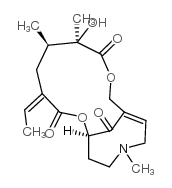Hepatotoxic pyrrolizidine alkaloids in the Mexican medicinal plant Packera candidissima (Asteraceae: Senecioneae).
M Bah, R Bye, R Pereda-Miranda, Moustapha Bah, Robert Bye, Rogelio Pereda-Miranda
文献索引:J. Ethnopharmacol. 43(1) , 19-30, (1994)
全文:HTML全文
摘要
A study of the hepatotoxic pyrrolizidine alkaloids (PAs) contained in Packera candidissima (Greene) Weber & Löve (Senecio candidissimus Greene), a Mexican medicinal plant used for the treatment of kidney ailments and noted for its antiseptic properties, is reported. Analysis by TLC and GC-MS have shown the presence in high levels of both PAs and their N-oxides in the root (0.76% dry weight) and the aerial parts (0.36% dry weight) of the plant material. GC-MS analysis showed the presence of senecionine, integerrimine, retrorsine, and usaramine in the aerial parts. The root was found to contain senkirkine as the major component. These results indicate that users of this herb are at high risk of poisoning, especially members of certain cultural groups in Northern Mexico and the Hispanic population in the southwestern United States. In addition, two sesquiterpenes, neoadenostylone and epineoadenostylone were identified from the neutral extracts of this plant material. The 6 alpha-angeloyloxy-9-oxo-delta 10(1)-furanoeremophilane is reported for the first time as a natural product.
相关化合物
| 结构式 | 名称/CAS号 | 分子式 | 全部文献 |
|---|---|---|---|
 |
克氏千里光碱
CAS:2318-18-5 |
C19H27NO6 |
|
Diversity of pyrrolizidine alkaloids in native and invasive ...
2014-12-01 [Phytochemistry 108 , 137-46, (2014)] |
|
Determination of senkirkine and senecionine in Tussilago far...
2009-07-15 [Talanta 79(2) , 539-46, (2009)] |
|
Interplant alkaloid variation and Senecio vernalis toxicity ...
2001-06-01 [Vet. Hum. Toxicol. 43(3) , 147-51, (2001)] |
|
Mutagenic activity of the pyrrolizidine alkaloids seneciphyl...
1984-03-01 [Food Chem. Toxicol. 22(3) , 223-5, (1984)] |
|
Pyrrolizidine alkaloids from Senecio leucanthemifolius and S...
1993-01-01 [Nat. Toxins 1(4) , 241-5, (1993)] |